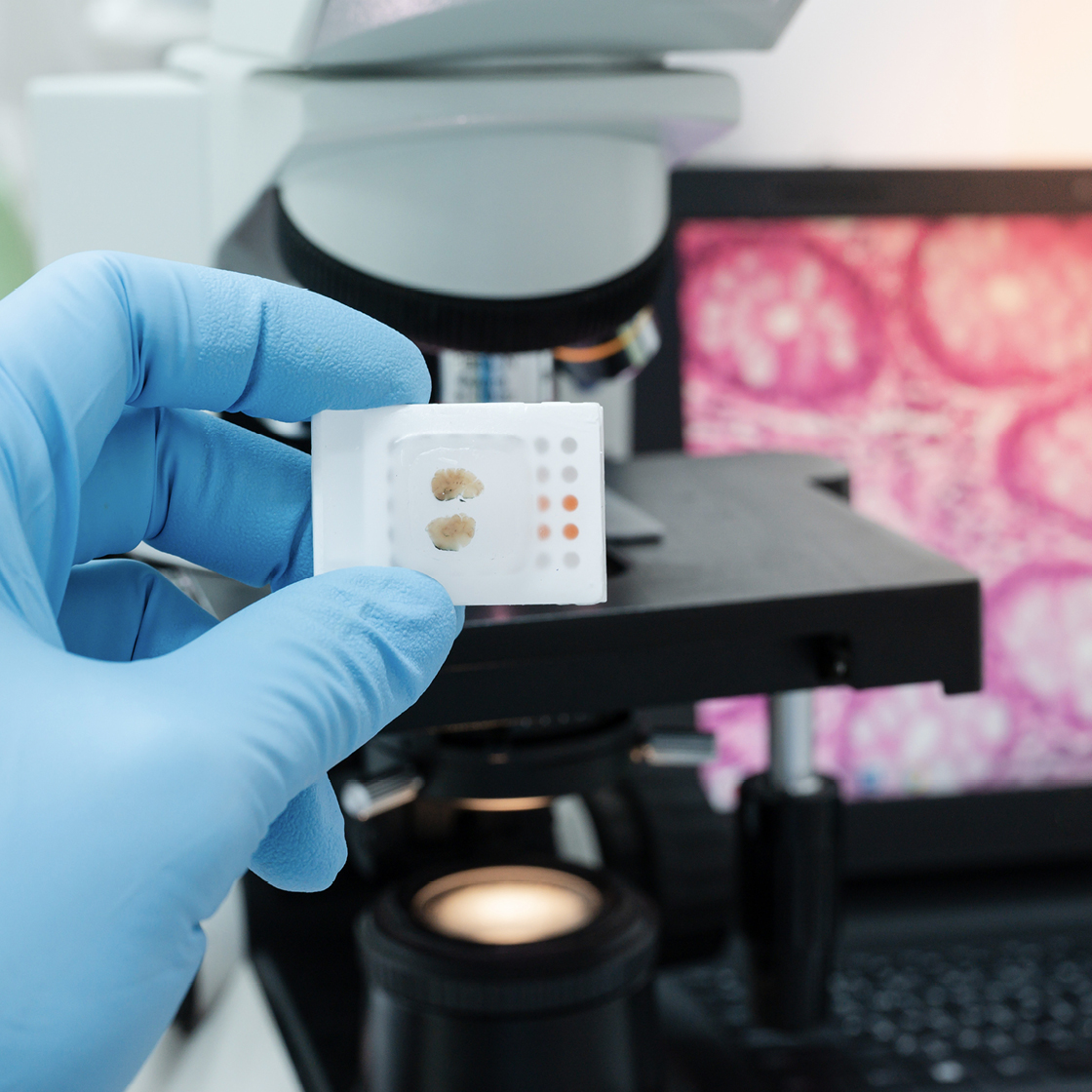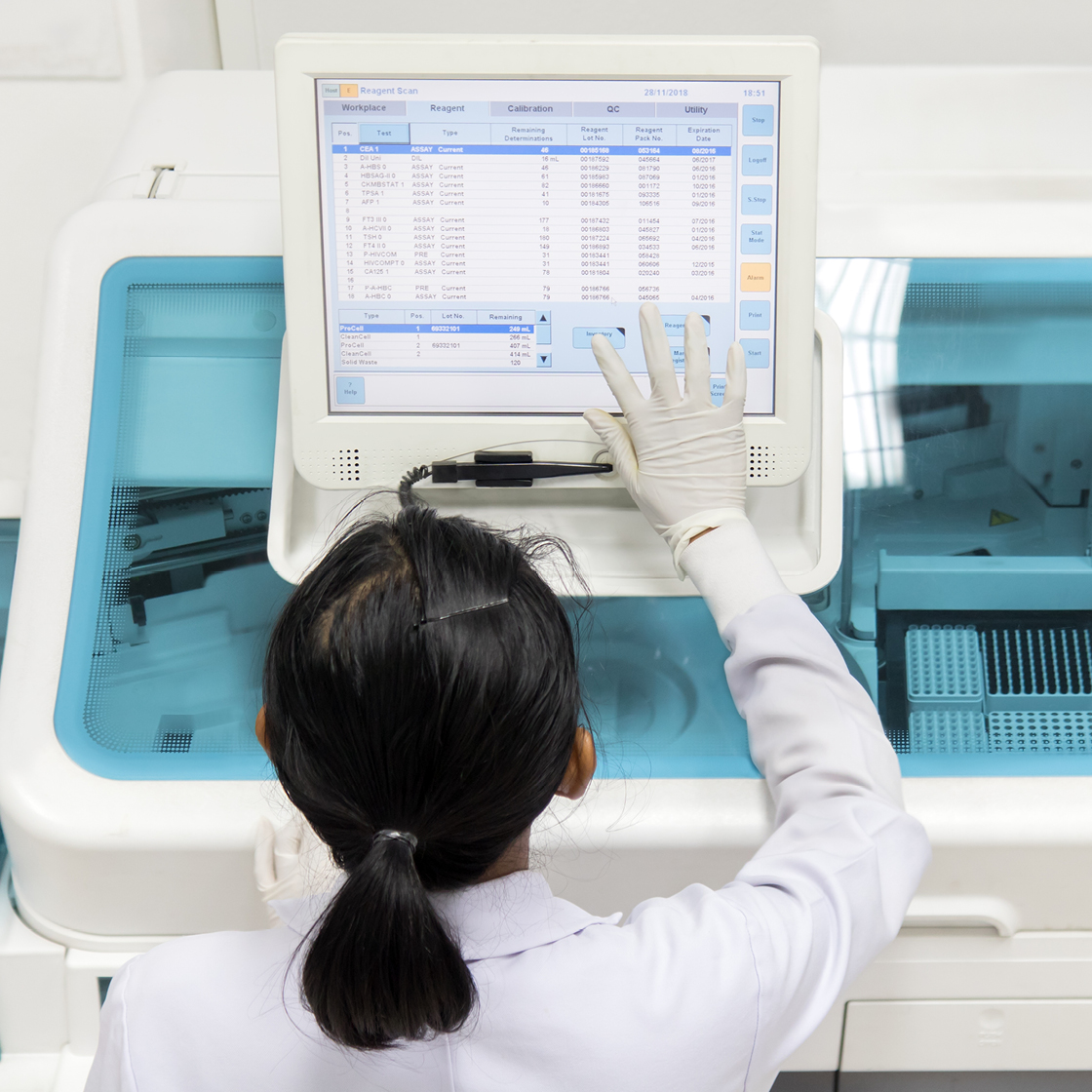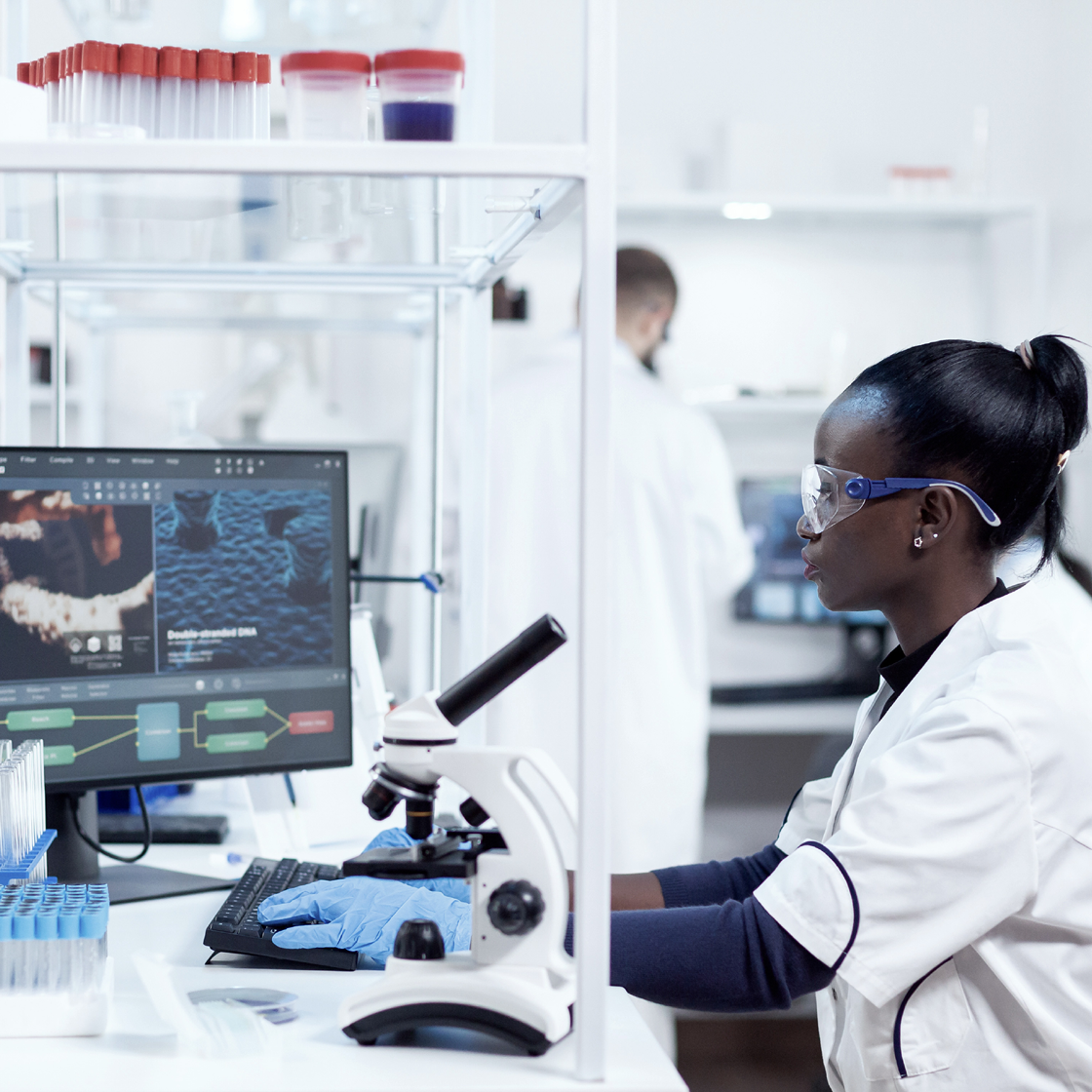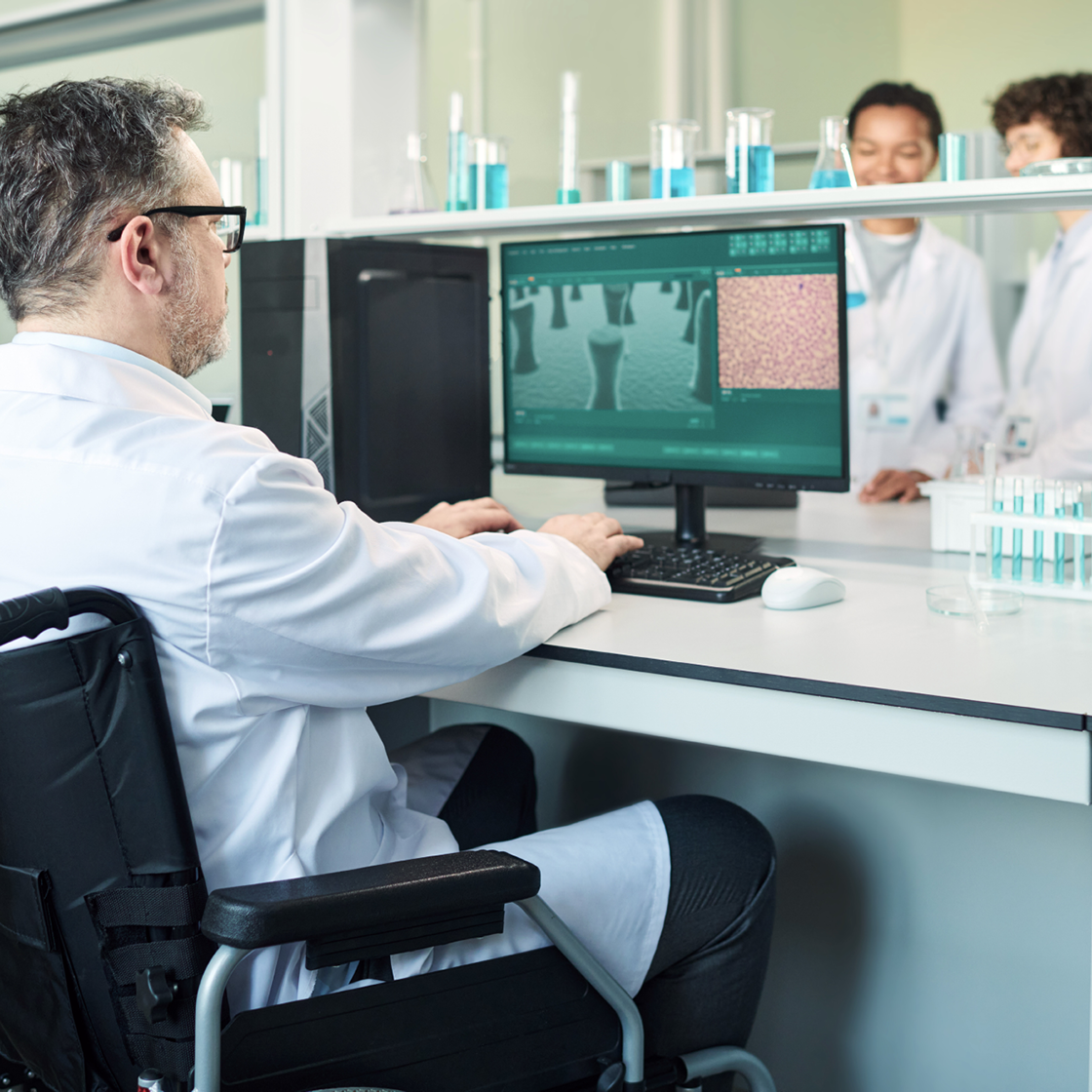Chapter 4
Building Toward the Future
The Next Generation of the Scientific Workplace
5 Minute Read
Access the full report
Change is coming—and in some cases, is already here. The life sciences sector faces immense pressure to grow and innovate. The lab of the future is set to reflect changes in the pharma landscape, but how labs are designed, how they operate and the way scientists interact with these new environments is key. Those who thrive will be defined by their readiness to adapt to change.
The future of the laboratory is geared towards increasing innovation, improving productivity, reducing operational inefficiencies and embracing new technologies. However, the introduction of change is inherently disruptive and open to conflict. But taking on a multi-faceted approach is central to managing transition and sustaining adoption while minimizing any disruption caused to the lab science environment and employees.
Even before COVID-19, the rise of automation and new technologies ignited a paradigm shift in the world of work, producing a need for large-scale upskilling and reskilling. In the life science workspace, laboratories are resetting the trajectory for development—from drug R&D through translational research to simple discovery—across the board, timelines have shrunk from years to months and budgets have reduced from billions to millions, while the speed-to-market has accelerated. This combination presents a compelling case for investment in organizational transformation.
Even before COVID-19, the rise of automation and new technologies ignited a paradigm shift in the world of work, producing a need for large-scale upskilling and reskilling.

Change management: mind the gap
As technology advancements continue to evolve, it is becoming ever-necessary for R&D heads and CSOs to embrace a technology-forward strategy to remain competitive among organizations of digital natives that center speed and flexibility. Although many companies have already started their journey through various measures, such as escalating the digital push to the C-suite and hiring chief digital officers, the life sciences sector is still in the shadows of other industries and remains to fully transform at scale.
To truly modernize the core technology and meet the digital aspirations of the life sciences industry, a significant overhaul is required. The industry at large has an opportunity to gain a true edge over competitors by leveraging and modernizing core technology. Given that life science laboratories that have embraced the digital revolution are few and far between, there is a first-mover advantage. We suggest some core moves to put into play to fully bring together all the ingredients necessary for a true core-technology transformation.
To truly modernize the core technology and meet the digital aspirations of the life sciences industry, a significant overhaul is required. The industry at large has an opportunity to gain a true edge over competitors by leveraging and modernizing core technology.
Unlock business potential with agile teamwork: a joint venture of tech and business experts
To stay adaptable in the fast-paced digital age, collaboration between business and technical teams should be a fundamental aspect of scientific operations. This requires an agile culture, which champions capitalizing on opportunities for value creation and preservation by redesigning strategy, structure, processes, staffing, financing, and technology.
Implement Automated Platforms for Maximum Efficiency and a Cloud-Centric Perspective
Having a clear plan for utilizing public and private clouds, along with a comprehensive platform strategy, is essential to achieve successful digital transformation. This plan should prioritize automation in all aspects of the process, from setting up new servers to implementing continuous delivery, testing, monitoring, and deployment. To ensure a smooth transition, breaking down the barriers between development and operations is essential. It is also important to have a holistic view of how current, traditionally hosted applications, as well as private-cloud platforms and public cloud workloads, will fit into the company's future.
To ensure a smooth transition, breaking down the barriers between development and operations is essential. It is also important to have a holistic view of how current, traditionally hosted applications, as well as private-cloud platforms and public cloud workloads, will fit into the company's future.

From engineers to game-changers: unleashing the power of our doers
Leading companies boast a roster of tech-savvy superstars who are experts in design, engineering, data science, and digital product ownership. To keep these all-stars shining, R&D leaders and CSOs must invest in career paths that hone the technical skills of the scientists, alongside managerial growth. By implementing incentive-based models and creating a culture centered on autonomy and ownership, organizations can foster an environment that empowers and celebrates growth.
Flexible by design: the power of modular and iterative architecture
Designing with common practices and protocols can enable teams to construct new infrastructure and update old systems with speed and efficiency. To foster growth and evolution, this approach emphasizes the breakdown of the interdependence of technology platforms (i.e., decoupling). The true test lies in the migration of existing systems to digital platforms without compromising compliance with regulations, such as good clinical practices, and data-privacy requirements.
Designing with common practices and protocols can enable teams to construct new infrastructure and update old systems with speed and efficiency.
Upskilling future-ready laboratory personnel
The next phase of industry is on the horizon and is revolutionizing the scientific processes rapidly, impacting globalization by changing the workforce and increasing access to new skills and knowledge.
In 2017 McKinsey reported that: 35
1 in 4
Business managers lacked a clear understanding of the impact of future automation and digitization on skill requirements
Almost 1 in 4
Said they lacked the tools or the knowledge to quantify the business case for efforts to reskill their workforce
Almost 1 in 4
Thought that their current HR infrastructure would not be able to execute a new strategy designed to address emerging skill gaps
The World Economic Forum projected in its Future of Jobs Report 2020 that half of all employees worldwide would need reskilling by 2025.34 This need has now become even more critical.
For future-fit labs to gain a competitive edge, attracting highly skilled personnel, upgrading infrastructure to accommodate a remote workforce, and providing training and development opportunities to current employees are key.
Change management for future-proof laboratories
With change on the horizon, the demand for the technology infrastructure required to support innovation and data strategies can be substantial. Indeed, the financial commitment required for on-premises technology infrastructure, including prolonged procurement processes and high fixed costs is significant and can pose a hurdle to progress. Though numerous companies around the world are turning to cloud-based, automated, and digitized solutions to support remote operations, they may not be capitalizing on all opportunities to refine their cloud and data approaches to drive innovation.
The early adoption of a formal change-management process--to assist the R&D leaders, CSOs and other stakeholders through the transformation in laboratory format or location and ways of working—is essential to ensure that the desired outcome of increased scientific productivity and innovation is met.
Figure 4: A Visual Representation of the Change Management Process

Source: Paul Janssenswillen, GWS Head of Scientific Projects, CBRE, 2023.
Change management is a definitive journey that begins with ideas and ends with a new workspace concept.

Events that typically take place as part of the change management process:
Preparation
Program preparation: Establish a clear program of change to guide the change-management process
Stakeholder mapping: Identify and map out key stakeholders for each business unit (BU) to ensure that all relevant parties are engaged in the process
Leadership consultation: Hold workplace discussions with BU leadership to gain input and feedback on proposed changes
Team representation: Select representatives from each BU team as ambassadors for their unit and provide feedback throughout the process
Workshop
Visioning workshops: Collaborative sessions to establish a shared vision and goals for the new laboratory environment
Feedback workshops: Provide an opportunity for BU team members to provide feedback on proposed changes
Focus groups: Smaller, targeted sessions to collect input from specific groups of BU team members
Team representation: Engage with BU team representatives to ensure that the needs and concerns of all team members are considered
Design & user assurance
Design reviews: In collaboration with BU leadership and team representatives, review and provide feedback on the new laboratory environment design
Design concept reviews: Provide an opportunity for BU team members to provide feedback on the new laboratory environment
Final review and acceptance: Ensure that the new laboratory workspace aligns with stakeholders’ needs and requirements
Post-occupancy assessments: Obtain feedback on the laboratory environment’s performance upon use
Developing facility strategies for the future lab
Since not all science is equal, the first step in the process of laboratory change is to engage in self-assessment of how laboratory space is used today and of the business priorities over the next several years.
At a minimum, organizations should be asking the following physical and behavioral questions:36
Physical
- What design elements of a research space can help researchers maintain focus and prevent cognitive overload? How does visual clutter in a laboratory environment impact clear thinking and creativity?
- What are some key obstacles that impede collaboration among researchers? What is the impact of a door that connects or separates spaces, even when left open, compared to just an opening in the wall? What role does a window between spaces play in fostering cognitive and physical proximity?
- How does the perception of flexibility in research space, as judged by a researcher's ability to easily modify it, influence their ability to do their best work?
- How crucial are transition spaces that provide a connection to the outdoors and external cues in helping researchers maintain a sense of orientation?
Behavioral
- How much does organizational or institutional culture contribute to fostering collaboration and collegiality, in comparison to architectural factors? To what extent is the success of this influenced by the individuals or the culture within the research entity?
- How crucial is the trust between researchers in this equation, exemplified by factors such as willingness to share equipment, keeping connecting doors open, or storing glassware in a semi-public corridor?
As we slide into the future, it's not hard to imagine a world where laboratories are nothing short of a technological wonderland. With automation, digitization, and advanced technologies such as AI and IoT, scientists will be able to conduct research at a speed and accuracy that was once thought impossible.
The laboratory of the future will be a highly advanced and integrated environment, leveraging cutting-edge technologies to drive efficiency and accuracy in research. Automation and digitization will be at the forefront, with the integration of artificial intelligence and machine learning allowing for more sophisticated data analysis. The IoT also promises to play a key role, enabling real-time monitoring and control of laboratory equipment and processes.
Virtual and augmented reality is poised to revolutionize the laboratory experience, facilitating enhanced collaboration and visualization of data. This will also democratize access—enabling remote access to the laboratory and facilitating collaborative experimentation and data analysis from anywhere in the world.
At its core, sustainability will also be a key focus—with mission statements moving from paper to reality, environment-friendly laboratory designs and practices becoming the norm. Portable, modular and flexible lab designs will allow for easy setup and reconfiguration, making it possible to conduct research in any setting.
One of the key challenges of implementing the lab of the future will be integrating new technologies and processes into existing laboratory infrastructure. This will require a comprehensive and well-planned change-management strategy that addresses technical, operational and cultural aspects.
The laboratory of the future will be much more than a home for scientific experimentation and discovery—it will be a hub for innovation and collaboration. With the integration of cutting-edge technology and a focus on efficiency, sustainability and safety, the future laboratory will drive advancements in various industries and improve the quality of life for all. The future is now, and it's time to start building the laboratory that will shape our tomorrow.
The laboratory of the future will be much more than a home for scientific experimentation and discovery—it will be a hub for innovation and collaboration. With the integration of cutting-edge technology and a focus on efficiency, sustainability and safety, the future laboratory will drive advancements in various industries and improve the quality of life for all

34 Schwab K & Zahidi S. (2020). The future of jobs report 2020. World Economic Forum, October 2020. Available from: https://www3.weforum.org/docs/WEF_Future_of_Jobs_2020.pdf. Last accessed January 2023.
35 McKinsey. Building the vital skills for the future of work in operations. Available from: https://www.mckinsey.com/capabilities/operations/our-insights/building-the-vital-skills-for-the-future-of-work-in-operations. Last accessed January 2023.
36 Goldstein RN. Architectural design and the collaborative research environment. Cell. 2006;127(2):243–246. doi: 10.1016/j.cell.2006.10.007.
Access the full report
Explore all 5 chapters of The Next Generation of the Scientific Workplace
Related Services
- Property Type
Life Sciences
We provide the life sciences industry solutions that maximize facility and investment performance across labs, manufacturing space and critical enviro...
Full Spectrum Lab Services from CBRE reduces lab inefficiencies and maximizes lab asset utilization through a range of unique services, exceptional da...
Optimize your lab instruments with our accredited labs, extensive certified scope and experienced talent.
Related Insights
- Figures
Despite Rising Vacancy, Life Sciences Real Estate Development Continues
April 24, 2023 2 Minute Read
Life sciences employment grew by 3.5% year-over-year in February, compared with 2.9% growth in total non-farm payrolls.
The U.S. life sciences industry has returned to a more normal pace at the start of 2023.
For life sciences companies, enabling smarter procurement and embracing innovation are two keys to facing the future with confidence.

